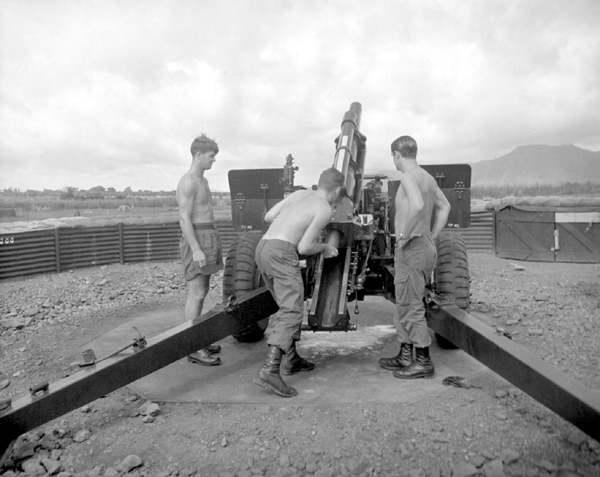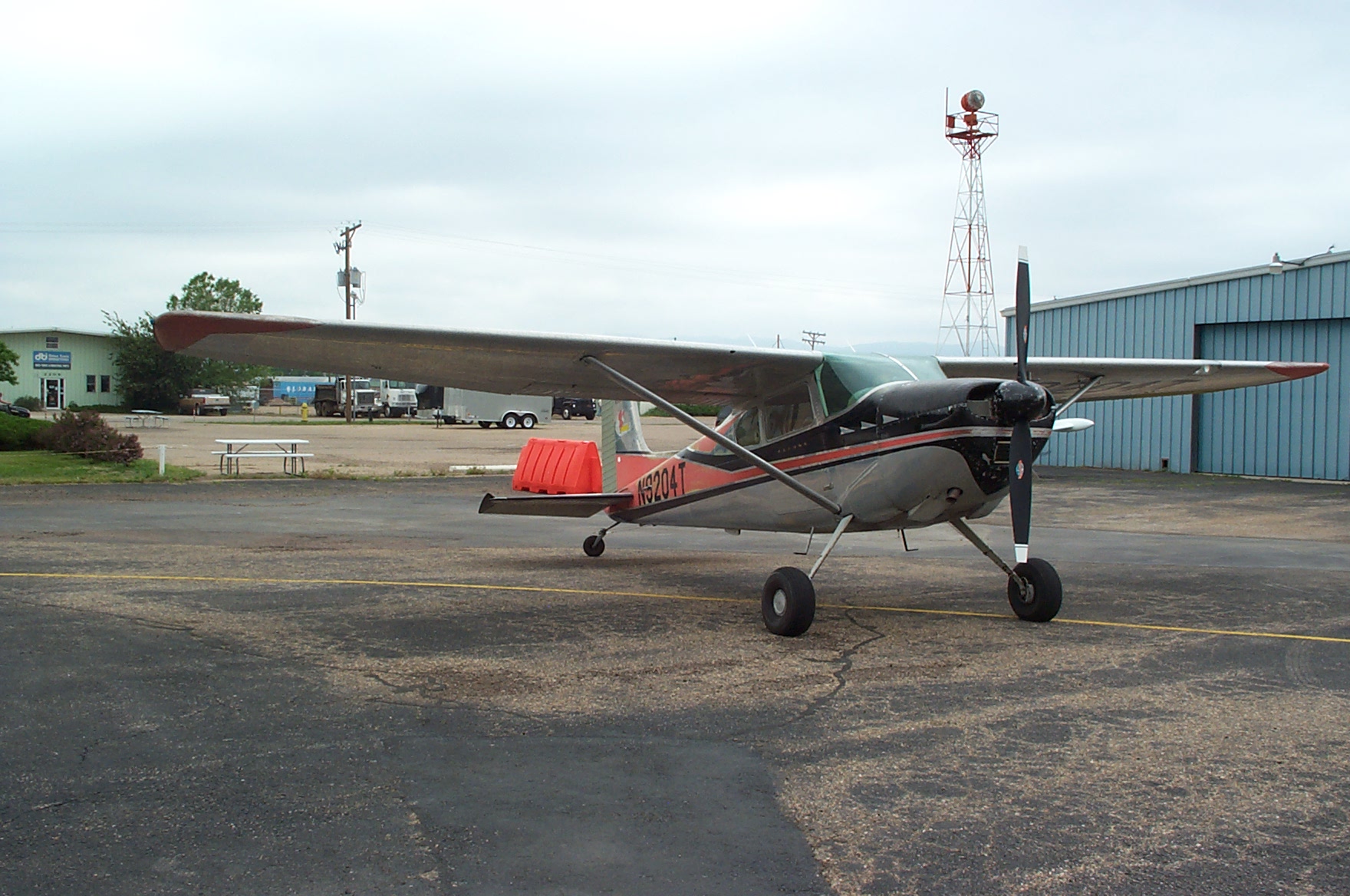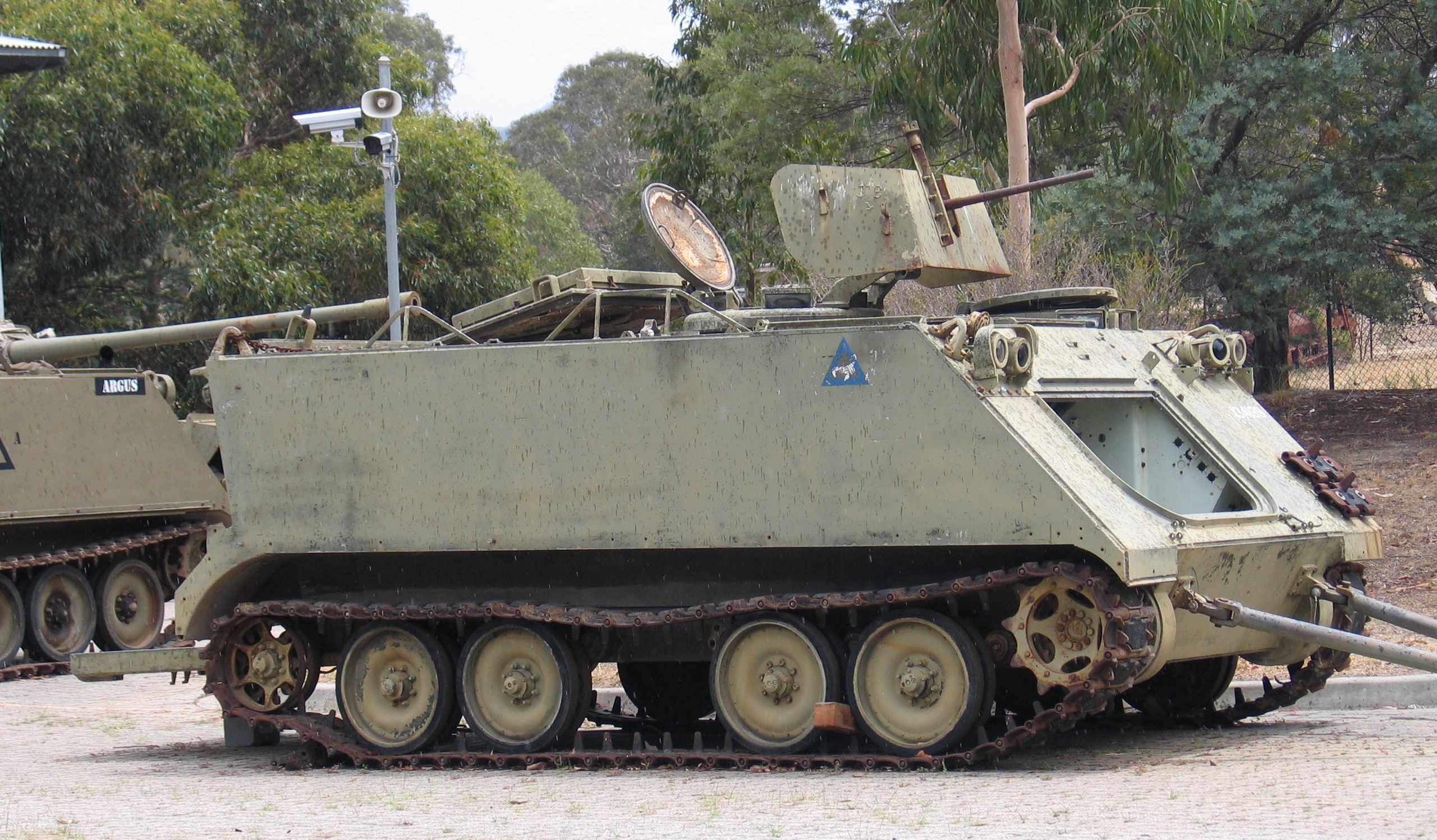|
Battle Of Suoi Bong Trang
The Battle of Suoi Bong Trang (23–24 February 1966) was an engagement fought between US, Australian and New Zealand forces, and the Viet Cong and North Vietnamese Army during the Vietnam War. The battle occurred during Operation Rolling Stone, an American security operation to protect engineers building a tactically important road in the vicinity of Tan Binh, in central Binh Duong Province, north-west of Bien Hoa airbase. During the fighting, soldiers from the US 1st Brigade, 1st Infantry Division and the 1st Battalion, Royal Australian Regiment (1 RAR), which had been attached for the operation, fought off a regimental-sized Viet Cong night assault. Repulsed by massed firepower from artillery and tanks, the Viet Cong suffered heavy casualties and were forced to withdraw by morning. After the attack, the Americans and Australians made no attempt to pursue the Viet Cong, focusing on securing the battlefield and evacuating their own casualties. The Viet Cong continued to hara ... [...More Info...] [...Related Items...] OR: [Wikipedia] [Google] [Baidu] |
Vietnam War
The Vietnam War (also known by #Names, other names) was a conflict in Vietnam, Laos, and Cambodia from 1 November 1955 to the fall of Saigon on 30 April 1975. It was the second of the Indochina Wars and was officially fought between North Vietnam and South Vietnam. The north was supported by the Soviet Union, China, and other communist states, while the south was United States in the Vietnam War, supported by the United States and other anti-communism, anti-communist Free World Military Forces, allies. The war is widely considered to be a Cold War-era proxy war. It lasted almost 20 years, with direct U.S. involvement ending in 1973. The conflict also spilled over into neighboring states, exacerbating the Laotian Civil War and the Cambodian Civil War, which ended with all three countries becoming communist states by 1975. After the French 1954 Geneva Conference, military withdrawal from Indochina in 1954 – following their defeat in the First Indochina War – the Viet Minh to ... [...More Info...] [...Related Items...] OR: [Wikipedia] [Google] [Baidu] |
War Zone C
War Zone C was the area in South Vietnam centered around the abandoned town of Katum near the Cambodian border where there was a strong concentration of People's Army of Vietnam (PAVN) and Viet Cong (VC) activity during the Vietnam War. This area was reportedly the general location of COSVN, the headquarters for communist military and political activities in the southern half of Vietnam. Geography War Zone C, located in the area designated as III Corps, was a section of South Vietnam with high strategic value due to its location in between Cambodia and Saigon as well as the fact that it was a popular jump off spot for PAVN/VC forces and supplies from the Ho Chi Minh Trail. War Zone C’s boundaries followed the Cambodian border to the north and west, while its eastern boundary ran parallel to Highway 13. The area included portions of Tay Ninh province, Binh Long province, and Binh Duong province. The area has been described as pathless jungles through mountainous regions and b ... [...More Info...] [...Related Items...] OR: [Wikipedia] [Google] [Baidu] |
1st Aviation Regiment (Australia)
The 1st Aviation Regiment is one of the Australian Army's three Army Aviation regiments and provides aerial reconnaissance and fire support to the Australian Army. The 1st Aviation Regiment, equipped with Eurocopter Tiger attack helicopters, forms part of the 16th Aviation Brigade and is based at Gaza Lines, Robertson Barracks, Darwin. History The Regiment was formed on 26 April 1966 as the 1st Division Army Aviation Regiment and was re-designated the 1st Aviation Regiment on 31 March 1967. The regiment had historically operated a mix of fixed-wing and rotary aircraft. In late 2004, the regiment was re-organised for its new role to operate the Tiger Armed Reconnaissance Helicopter (ARH). As part of this restructure, 171st Operational Support Squadron and 173rd Surveillance Squadron were placed as direct command units of the 16th Aviation Brigade. During 2005 and 2006, the regiment consolidated all of the remaining squadrons into one location for the first time, at Gaz ... [...More Info...] [...Related Items...] OR: [Wikipedia] [Google] [Baidu] |
Cessna 180
The Cessna 180 Skywagon is a four- or six-seat, fixed conventional gear general aviation airplane which was produced between 1953 and 1981. Though the design is no longer in production, many of these aircraft are still in use as personal aircraft and in utility roles such as bush flying.Christy, Joe ''The Complete Guide to the Single-Engine Cessnas'' 3rd ed, TAB Books, Blue Ridge Summit PA USA, 1979, pp 29–39 Development Cessna introduced the heavier and more powerful 180 as a complement to the Cessna 170. It eventually came to be known as the Skywagon. The prototype Cessna 180, N41697, first flew on May 26, 1952. Cessna engineering test pilot William D. Thompson was at the controls. In all its versions, 6,193 Cessna 180s were manufactured. In 1956, a tricycle gear version of this design was introduced as the Cessna 182, which came to bear the name Skylane. Additionally, in 1960, Cessna introduced a heavier, more powerful sibling to the 180, the conventional gear Cessna ... [...More Info...] [...Related Items...] OR: [Wikipedia] [Google] [Baidu] |
H-13 Sioux
H13, H-13 or H.13 may refer to: Roads * H-13 (Michigan county highway), a road in the United States * Highway H13 (Ukraine) Vehicles * Bell H-13 Sioux, an American helicopter * , a H-class submarine ordered by but not commissioned into the Royal Navy * Lioré et Olivier LeO H-13, a French flying boat * LSWR H13 class, a British steam railcar Other uses * DIN 1.2344 tool steel, a tool steel grade * London Buses route H13 This is a list of Transport for London (TfL) contracted bus routes in London, England, as well as commercial services that enter the Greater London area (except coaches). Bus services in London are operated by Abellio London, Arriva London, G ..., a public transportation route in England * A class of high-efficiency particulate air filter {{Letter-Number Combination Disambiguation ... [...More Info...] [...Related Items...] OR: [Wikipedia] [Google] [Baidu] |
1st Armoured Personnel Carrier Squadron (Australia)
The 1st Armoured Personnel Carrier Squadron (1 APC Sqn) was an armoured unit of the Australian Army raised for service during the Vietnam War. Raised in 1965, the unit was deployed to South Vietnam in May 1966 to join the 1st Australian Task Force. After that 1 APC Sqn was involved in numerous operations in support of the 5th and 6th Battalions, the Royal Australian Regiment, with the most notable action coming on 18 August 1966 when the squadron was involved in the Battle of Long Tan. In January 1967, 1 APC Sqn was redesignated as 'A' Squadron, 3rd Cavalry Regiment. History Formation 1 APC Sqn has a convoluted history. Officially the unit was first raised at Puckapunyal, Victoria, on 1 July 1965; however, the squadron also draws lineage from 1 Troop, 'A' Squadron, 4th/19th Prince of Wales's Light Horse (1 Tp A Sqn 4/19 PWLH). 1 Tp A Sqn 4/19 PWLH was a Regular sub unit of a primarily Citizens Military Force light cavalry regiment. In June 1965, this unit was converted from Sala ... [...More Info...] [...Related Items...] OR: [Wikipedia] [Google] [Baidu] |
William E
William is a male given name of Germanic origin.Hanks, Hardcastle and Hodges, ''Oxford Dictionary of First Names'', Oxford University Press, 2nd edition, , p. 276. It became very popular in the English language after the Norman conquest of England in 1066,All Things William"Meaning & Origin of the Name"/ref> and remained so throughout the Middle Ages and into the modern era. It is sometimes abbreviated "Wm." Shortened familiar versions in English include Will, Wills, Willy, Willie, Bill, and Billy. A common Irish form is Liam. Scottish diminutives include Wull, Willie or Wullie (as in Oor Wullie or the play ''Douglas''). Female forms are Willa, Willemina, Wilma and Wilhelmina. Etymology William is related to the given name ''Wilhelm'' (cf. Proto-Germanic ᚹᛁᛚᛃᚨᚺᛖᛚᛗᚨᛉ, ''*Wiljahelmaz'' > German ''Wilhelm'' and Old Norse ᚢᛁᛚᛋᛅᚼᛅᛚᛘᛅᛋ, ''Vilhjálmr''). By regular sound changes, the native, inherited English form of the name should b ... [...More Info...] [...Related Items...] OR: [Wikipedia] [Google] [Baidu] |
Major General (United States)
In the United States Armed Forces, a major general is a two-star general officer in the United States Army, Marine Corps, Air Force, and Space Force. A major general ranks above a brigadier general and below a lieutenant general. The pay grade of major general is O-8. It is equivalent to the rank of rear admiral in the other United States uniformed services which use naval ranks. It is abbreviated as MG in the Army, MajGen in the Marine Corps, and in the Air Force and Space Force. Major general is the highest permanent peacetime rank in the uniformed services as higher ranks are technically temporary and linked to specific positions, although virtually all officers promoted to those ranks are approved to retire at their highest earned rank. A major general typically commands division-sized units of 10,000 to 15,000 soldiers. The Civil Air Patrol also uses the rank of major general, which is its highest rank and is held only by its national commander. Statutory limits ... [...More Info...] [...Related Items...] OR: [Wikipedia] [Google] [Baidu] |
173rd Airborne Brigade Combat Team
The 173rd Airborne Brigade ("Sky Soldiers") is an airborne infantry brigade combat team (IBCT) of the United States Army based in Vicenza, Italy. It is the United States European Command's conventional airborne strategic response force for Europe.The 173rd Airborne Brigade History, Our History skysoldiers.army.mil, last accessed 21 December 2020 Activated in 1915, as the 173rd Infantry Brigade, the unit saw service in but is best known for its actions during the . The brigade was the first major United States Army ground fo ... [...More Info...] [...Related Items...] OR: [Wikipedia] [Google] [Baidu] |
Lai Khe
Lai or LAI may refer to: Abbreviations * Austrian Latin America Institute (Österreichisches Lateinamerika-Institut) * ''Latin American Idol'', TV series * La Trobe Institute, Melbourne, Australia * Leaf area index, leaf area of a crop or vegetation per unit ground area * Liga Atlética Interuniversitaria de Puerto Rico * Location Area Identity Places * Lai (state) (萊), 6th-century BC state in present-day Shandong, China *Bolyu language, also known as Lai * Laï, city in Chad * Lai, Iran (other), places in Iran * Lai, village in Lum Choar, Cambodia * ''Lai'', Romansch name for Lenzerheide, a village in Switzerland * Lannion – Côte de Granit Airport Surname * Francis Lai (1932–2018), French composer * Valentino Lai (born 1984), Swedish football player * Lai (surname) 黎丶賴, Chinese surname * Lí (surname 黎), Lai in Cantonese Other * Battle of Lai, during World War I * Lai people, ethnic group of Mizoram, North East India * Lai languages The Lai ... [...More Info...] [...Related Items...] OR: [Wikipedia] [Google] [Baidu] |
Phước Vĩnh Base Camp
Phước Vĩnh Base Camp (also known as Phước Vĩnh Combat Base) is a former U.S. Army base north of Biên Hòa in southern Vietnam. History The base was established in mid-1965 and was located approximately 35 km north of Biên Hòa in Phước Thành Province. The 1st Brigade, 1st Infantry Division comprising: * 1st Battalion, 2nd Infantry Regiment * 1st Battalion, 16th Infantry Regiment (December 1965-November 1966) * 1st Battalion, 26th Infantry Regiment *1st Battalion, 28th Infantry Regiment * 2nd Battalion, 28th Infantry Regiment (December 1965-November 1966) was based at Phước Vĩnh from December 1965 until February 1968. The 506th Infantry Regiment moved to the base in December 1967 as part of Operation Uniontown and remained there until October 1968. In November 1968 the 1st Cavalry Division moved here from Camp Evans as part of Operation Liberty Canyon and would remain based here until April 1971. Other units stationed at Phước Vĩnh included: * 5 ... [...More Info...] [...Related Items...] OR: [Wikipedia] [Google] [Baidu] |




